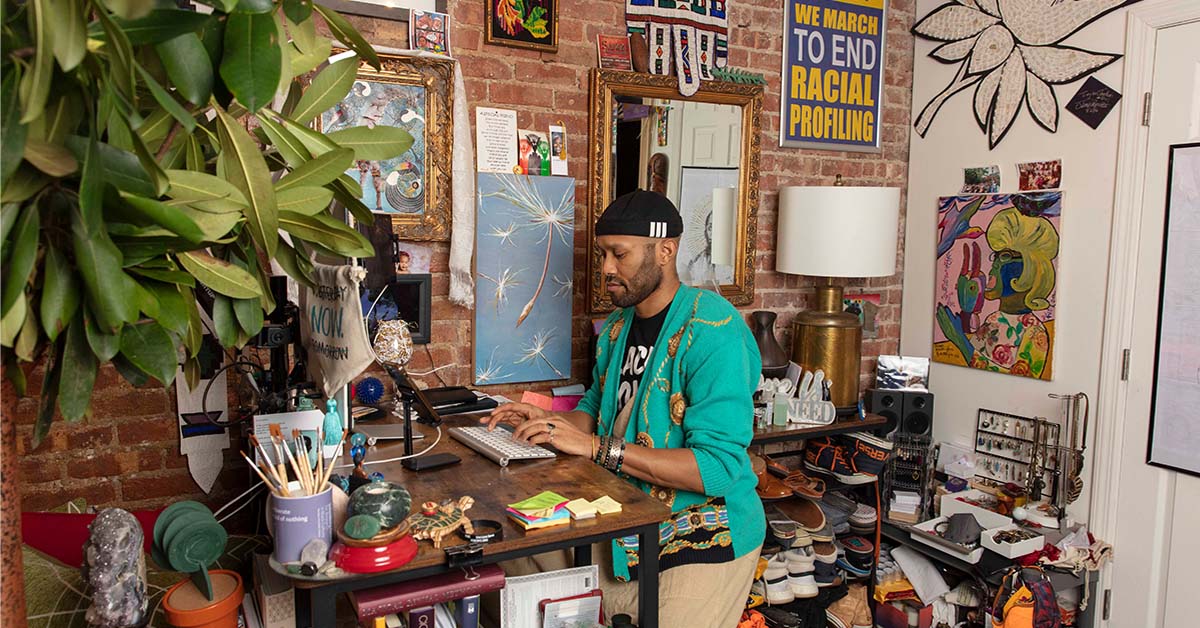Blog editor’s note: This #BlackHistoryMonth, 23andMe employees are discussing the resiliency and joy in the Black and African diaspora. While we reflect on the past, share and recognize Black stories and history, we’re also looking ahead toward the future. This month we’ve curated guest blogs from people who embody that joy, and resiliency and are making that future a reality. Today’ we meet Jonathan McCory the executive artistic director of the National Black Theatre.
By Melissa Kimble
Founded in Harlem in 1968 by the mother of the Black Arts movement, Dr. Barbara Ann Teer, the National Black Theatre is the country’s first revenue generating Black arts complex and the longest running Black theater in the world.
The theater’s current Executive Artistic Director, Jonathan McCrory, honors the founder’s principles of ownership, self-determination and human transformation, while he and his team confront the enormous challenges the Black community faces today.
For Jonathan it has meant that for the last decade serving as director of the theater he must lead “ courageously with this notion of Black liberation and bringing your ancestors with you.”
Throughout history, the National Black Theatre has been a refuge for Black artists by creating a safe space for their creativity, their art, and holding ground for their transformation. As one of the oldest theaters founded and consistently operated by a woman of color in the nation, the core mission has always been to be the premier producer of transformative theatre — theatre that enhances African American cultural identity by telling authentic, autonomous, multifaceted stories of the Black experience. This experience and exchange leads to art’s true intention, which is to heal.

Photo by Giancarlo Valentine
Nurturing Black Artists
Jonathan’s own journey to the theater was one that was already full of intentionality, nurturing Black artists and voices. That started with himself. The award winning director, producer, and artist, made a declaration in high school about his career destination. He decided that he wanted to run a Black theater in Harlem that owned their own space dedicated to doing work for Black artists. “When I decided to name myself as a Black artist, that destination was my birthright,” he says“I needed to also establish that birthright for future Black artists. I wanted to be a part of that awakening inside the psyche of the individual.”
McCrory describes his role as a “creative doula,” one who takes care of artists’, mental, creative, and artistic “wealth.” Jonathan works with a dynamic team of people with the collective mission of ensuring that the creative work of Black artists, and their voices are well resourced and pulled to the forefront. His vision for the theater embodies welcoming in and investing in the next generation of Black artists and change-makers in theatre.
“Sometimes people don’t see themselves as producers because they think it’s tied to economics,” he says. “How do we see our culture as an economic tool, knowing that we contribute billions into the economic pipeline? How can we reclaim some of that intellectual property, some of that wealth knowledge and start to actually create spaces of ownership, where we actually lead the producer or the producers of that cultural product.”
“The National Black Theatre’s core mission lies in human transformation,” McCory said.
Looking Towards The Future
McCrory and his team are in the middle of revisioning the theater to service Black artistic changemakers now and in the future. Externally they’re undergoing a physical transformation with a capital redevelopment project and are working towards building a brand new cultural destination and facility for the organization. This new phase of the theater will include artist housing with a twenty story high-rise. The reimagining of their facility will include a studio for theatrical works, a temple of liberation where artists will be able to do immersive storytelling using 3D, XR and potentially VR technology.
“We are seeking to create a cutting edge new facility that leans into the curiosity of Black innovation that allows for Black artists to find ways in which to find economics, to actually be able to update a benefit inside of the work that they’re able to produce,” he says. “To allow for a more diverse poly of voices to be able to change and radically benefit and actually inform the cultural expression that we all love and are working on.”
The organizations offerings include a theater arts program that’s a three prong program to give artists space to be alchemists: Their Soul Series Lab program is one of the only programs in the country dedicated to Black artists; their playwrights residency is the only residency in the country that provides an eighteen month home for Black playwrights; and their producer residency program is generating the next level of cultural producers.

Photo by Giancarlo Valentine
Theatre In The Digital World
McCrory is also stewarding the build out of their digital platform to ensure so the theater can connect with those who may not ever feel comfortable being in physical spaces again due to the pandemic. He cites their merch line, their Instagram page, and budding partnerships with national potential as extensions to connect and to be a vessel for new possibilities, a notion that is embedded into his leadership style and approach. Many times you will catch McCrory donning a shirt or hat with the word “joy” on it. As a personal advocate of artistic expression being the vehicle towards joy and healing, McCrory wants to create conditions with joy as a bedrock.

Photo by Giancarlo Valentine
“There should be an acknowledgement that although the pandemic has caused a lot of sadness, a lot of grief, it also created the space for us to innovate how we communicate and how we process the way we live our lives,” he says. McCrory looks toward the future with a generosity that is needed now more than ever.
“We seek to lean into the curiosity of what does it mean to see someone? What happens if they feel seen? And if they feel seen, what does someone get to become?” he says. “That simple question awakens a radical new universe of possibilities. Then we become the vessels of manifestation, the tools to allow for unseen, unfinished work to be possible seen through our lifetime.”
This radical vision is one that Jonathan and his team still carry on in the present times in the shadow of racial upheaval and the pandemic. They are modifying their approach to continue to be a refuge for Black art and creativity.
“To lead with a graceful institute is to actually tap in and tune into the wisdom of our ancestors as a fortitude and a fortress to actually awaken human transformation. It is the gate keeping tool and mechanism to unlock what I think human transformation can look like.” As we learn to count our blessings to heal our way forward during these times, we can rest assured that the National Black Theatre will continue to light the way.


